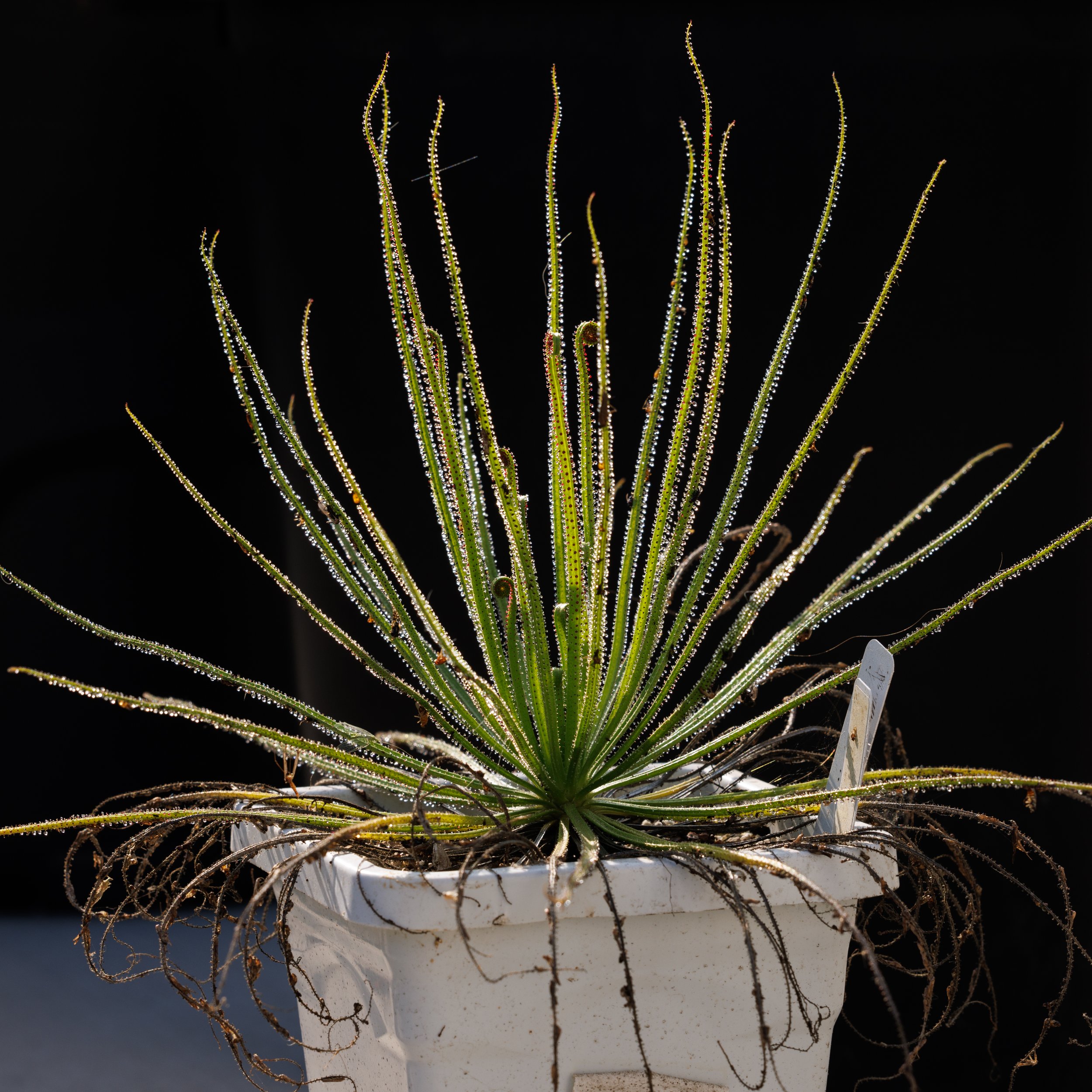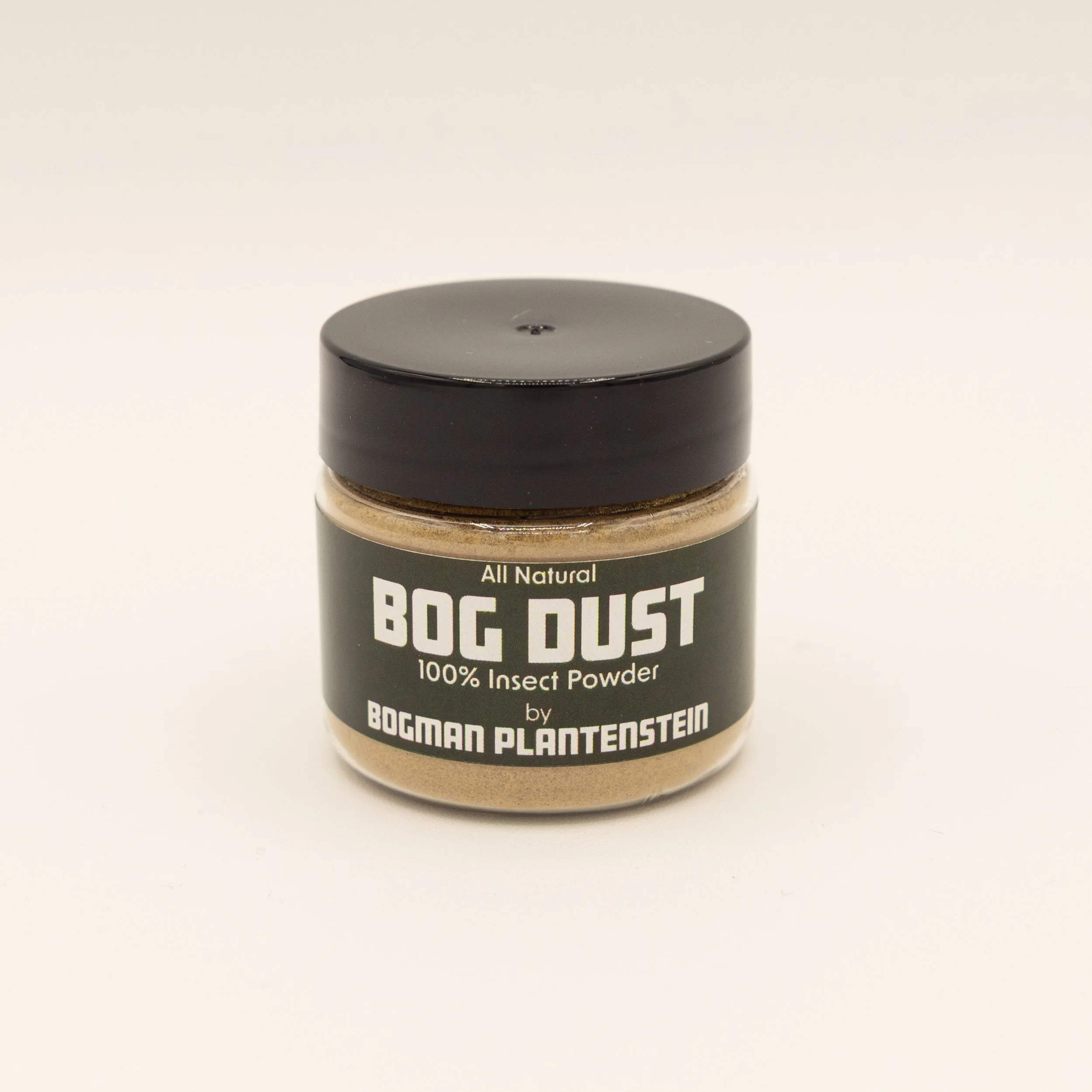 Image 1 of 10
Image 1 of 10

 Image 2 of 10
Image 2 of 10

 Image 3 of 10
Image 3 of 10

 Image 4 of 10
Image 4 of 10

 Image 5 of 10
Image 5 of 10

 Image 6 of 10
Image 6 of 10

 Image 7 of 10
Image 7 of 10

 Image 8 of 10
Image 8 of 10

 Image 9 of 10
Image 9 of 10

 Image 10 of 10
Image 10 of 10











Dewy Pine (Drosophyllum lusitanicum)
Description
Dewy Pines (Drosophyllum lusitanicum) are some of the best flycatchers of all the carnivorous plants while also smelling like honey! They have thin, green leaves with red, mushroom-shaped dew glands that produce a viscous, sticky substance like sundews. However, Dewy Pines are only distantly related to sundews, flytraps, and Asian pitcher plants (Nepenthes).
If left outdoors in bright sun, they can catch incredible quantities of insects — sometimes every leaf of the plant is covered in prey. They can rapidly grow to over 1’ in diameter in under a year, maxing out at around 2’ in diameter.
Looking almost like a glistening tuft of pine needles, Dewy Pines glisten in the sun and emit a pure, sweet, syrupy (and very appetizing) aroma. They require high amounts of sun or intense LED grow lights. Unlike many tropical or bog carnivorous plants, these grow in gravely, dry coastal hills in Portugal, Spain, and Morocco that get regular morning fog.
Dewy Pines can be tricky at first, but manageable once their basic needs are met. It can grow from seed to maturity in roughly a year, and then will produce large, brilliant yellow flowers. These will produce hard black seeds.
The plants for sale are juvenile plants with leaves around 2” long, in peat pots. The peat pots will need to be planted directly into a large pot (over 6” diameter, the larger the better) with appropriate soil since root disturbance is often fatal. Photos 2 represents the approximate size of the plant you will receive in a biodegradable pot.
NOTE: These require a heat pack in cold weather to guarantee live arrival! Check the next week of your local weather and if there are highs below 40F or lows below 30F then you must add a heat pack as an add-on or from the “Supplies” section. Only one heat pack is needed per order.
How to Plant Upon Arrival
The Dewy Pine will arrive in a peat pot, wrapped to protect the small seedling. Carefully and gently unwrap the pot from the packaging. The peat pot will need to be potted into the plant’s final pot since root disturbance is almost always fatal. Use as large a pot as you can to allow the most room for root growth and longevity, typically a #1 gallon nursery pot is the smallest size that can work for at least a year. Ideally, use an 8”-12”+ deep pot to give room for the roots to grow.
Mix up appropriate soil and fill the new pot, then dig a hole in the center for the peat pot. It is helpful to poke some holes into the peat pot to allow the roots to escape (but not necessary since they can just burst through eventually). The peat pot can be fragile because it is meant to decompose, so handle with care. Place the peat pot in the hole and fill the soil in around the peat pot all the way to the edge (or even over the edge of the peat pot). The roots will soon grow through the peat pot into the larger pot.
Water lightly and regularly (around every other day) while the plant is establishing. Watering frequency will depend on your exact climate. While young, they can tolerate wetter conditions but as they increase in size prefer to be kept only slightly moist in the soil. The pot should be able to easily drain excess water and the soil mix should readily drain! This plant wants to be drier than most other carnivorous plants. Terracotta helps to wick excess water out of the pot. Always give your Dewy Pine good airflow and drainage because they are susceptible to rot.
These require at an absolute minimum, 6 hours of direct, strong sunlight per day. This is not optional. Aim for 6-12 hours of sun or extremely powerful LED grow lights meant to mimic full sun conditions (I’ve used 50W per sq foot successfully, but sun is better).
Growing Information
Climate: Temperatures of 30F- 90F are fine. They may become stressed during very hot conditions, but can recover once temperatures cool down to below 85F. While they can survive light frost, it is best to keep them above freezing.
Light: Full Sun or at least 40W per sq ft LED light. Very bright light is essential. These should be grown outdoors.
Water: Lightly top water the surface of the pot to maintain moist conditions. Dewy pines want well draining, airy, moist soils (not sitting in trays of water). Give them slightly more water when small (<5” tall) and progressively less water as they grow larger. When first planted, give extra water for a couple weeks as the roots establish themselves in the new soil. Only use distilled, reverse osmosis, or rainwater because tap water is toxic to carnivorous plants due to high mineral content and chlorine.
Soil: A granular, well draining mix like 40% decomposed granite: 60% perlite (maybe a pinch of peat but not sure if necessary). The mix should be well-draining, airy, and inorganic — they are not picky as long as they get enough sun and consistent moisture levels.
Feeding: Leaves can be fed with Insect Powder slurry/powder, or insects, though plants outdoors are generally covered with bugs and do not require supplementary feeding.
Description
Dewy Pines (Drosophyllum lusitanicum) are some of the best flycatchers of all the carnivorous plants while also smelling like honey! They have thin, green leaves with red, mushroom-shaped dew glands that produce a viscous, sticky substance like sundews. However, Dewy Pines are only distantly related to sundews, flytraps, and Asian pitcher plants (Nepenthes).
If left outdoors in bright sun, they can catch incredible quantities of insects — sometimes every leaf of the plant is covered in prey. They can rapidly grow to over 1’ in diameter in under a year, maxing out at around 2’ in diameter.
Looking almost like a glistening tuft of pine needles, Dewy Pines glisten in the sun and emit a pure, sweet, syrupy (and very appetizing) aroma. They require high amounts of sun or intense LED grow lights. Unlike many tropical or bog carnivorous plants, these grow in gravely, dry coastal hills in Portugal, Spain, and Morocco that get regular morning fog.
Dewy Pines can be tricky at first, but manageable once their basic needs are met. It can grow from seed to maturity in roughly a year, and then will produce large, brilliant yellow flowers. These will produce hard black seeds.
The plants for sale are juvenile plants with leaves around 2” long, in peat pots. The peat pots will need to be planted directly into a large pot (over 6” diameter, the larger the better) with appropriate soil since root disturbance is often fatal. Photos 2 represents the approximate size of the plant you will receive in a biodegradable pot.
NOTE: These require a heat pack in cold weather to guarantee live arrival! Check the next week of your local weather and if there are highs below 40F or lows below 30F then you must add a heat pack as an add-on or from the “Supplies” section. Only one heat pack is needed per order.
How to Plant Upon Arrival
The Dewy Pine will arrive in a peat pot, wrapped to protect the small seedling. Carefully and gently unwrap the pot from the packaging. The peat pot will need to be potted into the plant’s final pot since root disturbance is almost always fatal. Use as large a pot as you can to allow the most room for root growth and longevity, typically a #1 gallon nursery pot is the smallest size that can work for at least a year. Ideally, use an 8”-12”+ deep pot to give room for the roots to grow.
Mix up appropriate soil and fill the new pot, then dig a hole in the center for the peat pot. It is helpful to poke some holes into the peat pot to allow the roots to escape (but not necessary since they can just burst through eventually). The peat pot can be fragile because it is meant to decompose, so handle with care. Place the peat pot in the hole and fill the soil in around the peat pot all the way to the edge (or even over the edge of the peat pot). The roots will soon grow through the peat pot into the larger pot.
Water lightly and regularly (around every other day) while the plant is establishing. Watering frequency will depend on your exact climate. While young, they can tolerate wetter conditions but as they increase in size prefer to be kept only slightly moist in the soil. The pot should be able to easily drain excess water and the soil mix should readily drain! This plant wants to be drier than most other carnivorous plants. Terracotta helps to wick excess water out of the pot. Always give your Dewy Pine good airflow and drainage because they are susceptible to rot.
These require at an absolute minimum, 6 hours of direct, strong sunlight per day. This is not optional. Aim for 6-12 hours of sun or extremely powerful LED grow lights meant to mimic full sun conditions (I’ve used 50W per sq foot successfully, but sun is better).
Growing Information
Climate: Temperatures of 30F- 90F are fine. They may become stressed during very hot conditions, but can recover once temperatures cool down to below 85F. While they can survive light frost, it is best to keep them above freezing.
Light: Full Sun or at least 40W per sq ft LED light. Very bright light is essential. These should be grown outdoors.
Water: Lightly top water the surface of the pot to maintain moist conditions. Dewy pines want well draining, airy, moist soils (not sitting in trays of water). Give them slightly more water when small (<5” tall) and progressively less water as they grow larger. When first planted, give extra water for a couple weeks as the roots establish themselves in the new soil. Only use distilled, reverse osmosis, or rainwater because tap water is toxic to carnivorous plants due to high mineral content and chlorine.
Soil: A granular, well draining mix like 40% decomposed granite: 60% perlite (maybe a pinch of peat but not sure if necessary). The mix should be well-draining, airy, and inorganic — they are not picky as long as they get enough sun and consistent moisture levels.
Feeding: Leaves can be fed with Insect Powder slurry/powder, or insects, though plants outdoors are generally covered with bugs and do not require supplementary feeding.
More growing information from the International Carnivorous Plant Society can be found here: https://www.carnivorousplants.org/grow/guides/Drosophyllum


